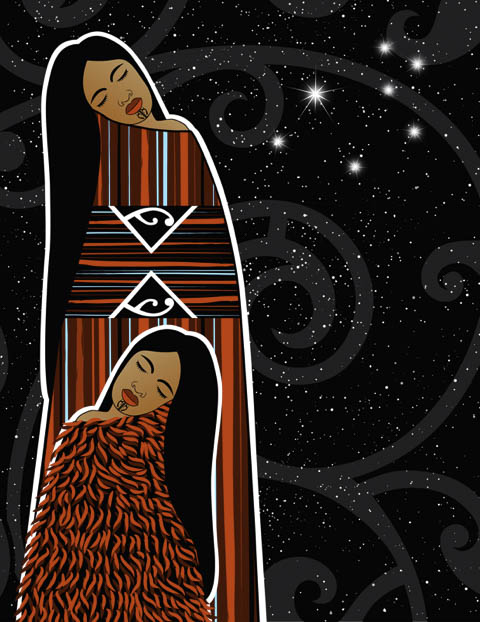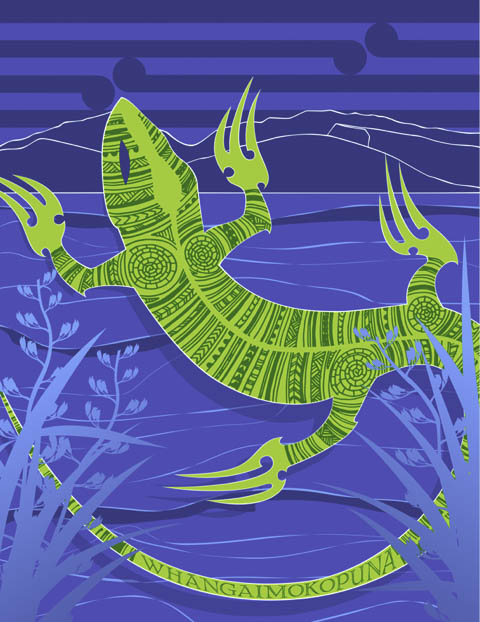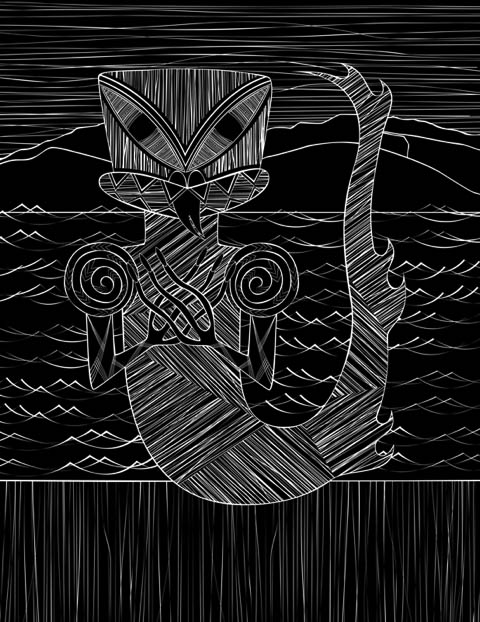TRADITIONAL LOCAL STORIES

The jealous sisters of the Ruamahanga
In the distant past, many Maori tribes lived along the rich river flats of the Wairarapa valley and beside the main tributaries of the Ruamahanga River from which the name “Ruamahanga”, meaning “many tributaries”, is given. Among its other meanings, Rua means “two” or “both” and Mahunga means “either” or “two”.
For the purpose of our legend, we will assume that the river was named for the sisters, Rehutai, or mist of the breaking surf” and Tangimoana, or “the voice of the breaking surf”, who lived beside the river near Te Whiti.
So beautiful were the sisters that men were afraid to court them. They were proud maidens and enjoyed the power over which nature had endowed them.
One day a handsome Wairarapa warrior named Rautoroa, or “plume of the albatross”, having heard of the beautiful twins came to their kainga with gifts. Both girls were impressed with his looks and bearing. Their hearts went out to him and soon the sisters became jealous of each other.
Rautoroa did not know which girl to marry so he decided to bide his time.Rehutai asked her sister to fetch a calabash of water from a spring nearby. Tangimoana re fused to go unless her sister went with her as she did not relish the idea of Rehutai and Rautoroa being left along together.Rautoroa told hem that his thirst was so great that he needed two calabashes of water and so the two girls agreed to go.
When they came to the pool where the water was cool and clean, Tangimoana filled her calabash and then she pretended to stumble, disturbing the water and making it muddy and foul. Then she ran back to Rautoroa, leaving the enraged Rehutai to wait until the water had cleared before filling her calabash.When she returned she found Tangimoana wearing Rautoroa’s cloak, which according to tradition made her his wife.
Flinging the calabash aside, Rehutai snatched the whale-bone club from Rautoroa’s belt with the intention of killing her sister, but the love for her twin sister so overwhelmed her that she replaced the club and turned away. Making her way to a secret spot, she wept bitterly and made a mourning wreath of leaves for her head.
At dawn she left her kainga and walked until she came to a hill. She slowly climbed the hill until she disappeared into the mist and cloud at its crest and she was never seen again.
The hill is now known as Ohine-mokimoki, the place of the lonely girl.
Whangaimokopuna

The bed of the river (Manawatu) was affected by the exploits of a famous taniwha named Whängaimokopuna whose home was originally at the mouth of the river. Unlike most taniwha, Whängaimokopuna was a pet. His owners, the people of Motuiti, fed him on the choicest portions of eels caught in the area and apparently spoiled him thoroughly. One day when the elders were away, the children who had been left in charge of the pet saw no reason for coddling a taniwha, so they fed him on the heads of the eels, keeping the best portions for themselves. Whängaimokopuna was naturally upset and he seized one of the boys and swallowed him. When the elders returned the boy was missed, but while they were searching for him, their pet vomited up the boy’s remains. It was now the turn of the parents to be upset and Whängaimokopuna fled from their anger.
The taniwha went inland until the sound of the sea was inaudible, hence the name Taikorea (sea blotted out), now known as Taikoria.
Whängaimokopuna eventually decided to continue up the river and passed through the Manawatu Gorge. He carried on until he neared the point where the Tamaki River entered the Manawatu (between Tahoraiti and Dannevirke) where the river then took a sharp bend and passed round some high hills. Whängaimokopuna saw no point in travelling all that distance, so he simply cut his way straight ahead through the slopes of the hills, leaving a high cliff which later constituted part of the natural defences of the Rangitäne pa, Raikapua. This straightening of the river-bed left a depression on the south-east side of the river which is now partly occupied by the Mahangaiti Lagoon at Kaitoki.
Whängaimokopuna continued upstream till he reached the Mangapuaka Stream, which he followed until he reached its source in the hills now known as the Whangai Range after him. The Mangapuaka Stream had previously been the home of another taniwha named Te Horearua whose name is perpetuated in a peak, now a trig point, on the Raekatia Range south west of Ormondville. The taniwha still lives in the mountains and that whenever Rangitäne people from the lower Manawatu visit the Dannevirke area, a mist descends on Raekatia mountain. This is Whängaimokopuna weeping for his old friends.
Ngarara Huarau taniwha

Long ago a giant taniwha named Ngarara Huarau lived in a cave under the ground at Makorotai on the Heretaunga Plains (Hawke Bay). His family had all left, or died, and he was by himself. He was lonely and tired of living by himself in a cave so he decided to visit his sister Parikawhiti who lived in the Wairarapa.
With a great roar he came out of his cave and, with his mighty talons, split the land open leaving a huge chasm. In doing this some of his scales fell off and became Tuatara Lizards.
Setting out for the ocean he burst the land open and cut a big channel. This channel and the chasm filled with water and became the Tiraumea River.
Arriving at the great ocean of Kiwa he began his journey south to the Wairarapa. On his way he stopped at every river, lifting his head up high and sniffing to see if he could smell his sister. On arriving at the mouth of the Pahaoa River he became very tired and decided to rest there for a while.
He continued his journey south and swam up the Pahaoa River, into the Wainuioru River and finally the Marumaru stream. When he reached the far side of the Maungaraki hills behind Gladstone he was stopped by a very high steep hill. By this time he could smell his sister and knew she was near. He was very excited. He tried to jump to the top of the hill, but he kept slipping back. He tried again and again. At last he managed to get his feet on a ledge and jumped to the top leaving the marks of his footprints at a place called Hautua Pukurau o Ngarara Huarau.
He rested for a long time at the top. He could smell humans down in the valley below and hid himself from them. Later, he moved on down into the Kourarau Valley where he made a lair among the Kahikatea trees. From there he finally reached sister Parikawhiti, who lived in a cave in the side of the hill at a place near the present Gladstone Hotel. This place is named Te Ana o Parikawhiti.
Ngararau Huarau was happy to see his sister and decided to make a new lair in the Kourarau Valley where, soon after, he terrorised the local people. He caught and devoured any unsuspecting person who passed near. He also raided further affield. It became obvious to the people there that they would have to kill the taniwha before he devoured them all.
A young warrior called Tupurupuru, who lived in a nearby pa took it upon himself to kill this beast by setting a trap. Along with three of his friends he worked out a plan to take the taniwha by surprise.
Working quietly, while the taniwha was asleep, the men partly cut through the huge kahikatea trees around his lair. Then Tupurupuru crept up to the entrance and loosely tied a dog to a tree. As he crept away the dog began to bark and soon Ngarara Huarau appeared from inside his lair. With a great roar he rushed out of his lair thrashing his tail about. The dog broke free and ran through the trees where Tupurupuru and is friends were waiting. Ngarara Huarau was very angry and began to chase after the dog – roaring and thrashing his tail about. As the beast neared the trap his thrashing tail brought the partly cut trees crashing down on top, hurting him so badly that he was weakened by the injuries. The warriors immediately rushed up and began to kill the taniwha with their spears and clubs.
Ngarara Huarau managed to survive the brutal attack only to be driven into the swamp at Uwhiroa where he later drowned.